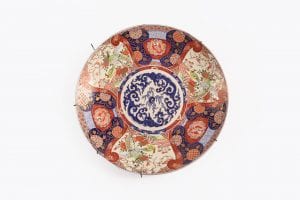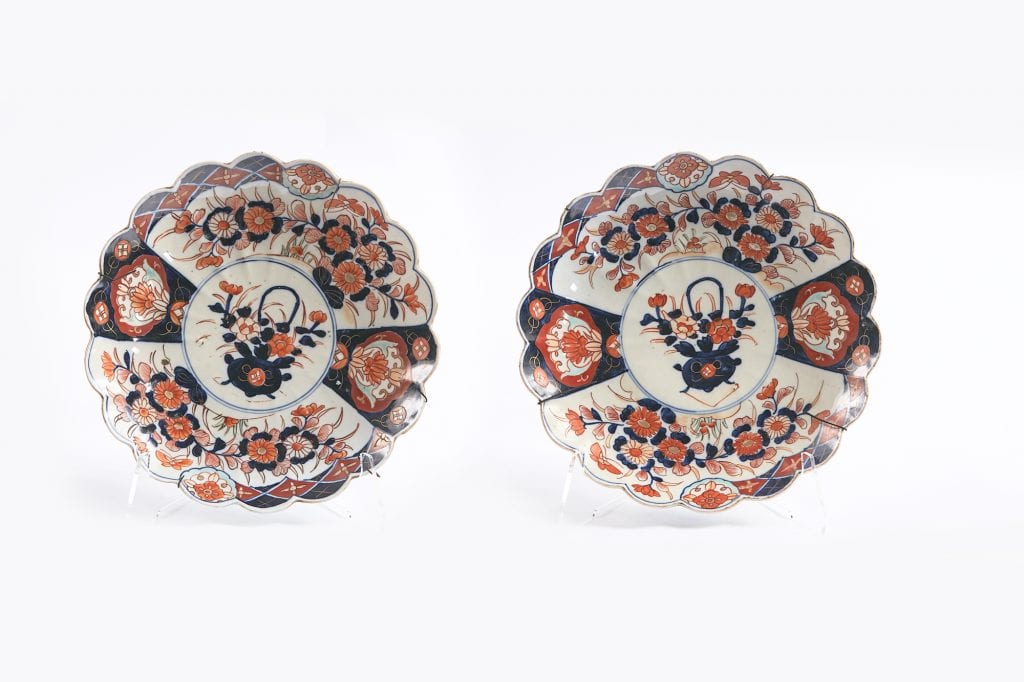The rare Japanese Imari ware or Arita ware porcelain was created at the the Arita kilns of the Hizen provence of Japan. The Arita porcelains are white glazed, pale grey blue or grey green glazed wares popularly called celadons, black wares and blue and white wares with underglaze painting and also with overglaze enamels. Porcelain manufacturing soon became a predominant industry within the region, fostered by the protection and strict monopoly policies of the Saga fief. The wares were shipped throughout the country and widely exported from the port of Imari by the Dutch East India Company to other parts of the world. Sometime before 1800, porcelain production had finally spread to other parts of Japan.
The development of Arita ware was largely influenced initially in its formative period by the influence of Korean craftsman and the popularity of Chinese wares, however by the mid 17th Century native Japanese designs began to dominate with overglazed enamelled porcelain such as Nabeshima, Kakiemon and old Imari. Nabeshima ware first appeared in the late 17th century. It is characterised by pictorial decoration deriving from fabrics, the use of subjects favoured by the Kanō and Tosa schools of painting, and the employment of fashionable highly refined and poised Edo-period decorative motifs. The mid 17th Century heralded the first enamelled ware entitled Kakiemon. Enamelled Kakiemon designs were inspired from the Japanese classical style of Yamato-e painting with luxurious ornamental colour palettes and pictorial decoration with decorative patterns inspired from fabric designs and pictorial motifs.
The image above depicts a 19th Century pair of Imari scalloped edge plates from the Meiji period. Central urn design, field glazed in the traditional orange, blue, green and white. I have also included some other rare and striking porcelain for you to view.
 A 19th Century Japanese large Imari porcelain charger decorated in the traditional manner with red, blue and gold glazes depicting hand painted countryside scenes with peacock birds and cherry blossom tree motif detail.
A 19th Century Japanese large Imari porcelain charger decorated in the traditional manner with red, blue and gold glazes depicting hand painted countryside scenes with peacock birds and cherry blossom tree motif detail.
 An Early 19th Century Regency Coalport Imari porcelain twenty nine piece dessert service, decorated in the ‘Japan’ style with a fenced garden of weeping willow and peony, the rim with brocade panels, comprising of one large oval serving dish, four oval platters, four bowls, four square serving dishes and sixteen circular plates, circa 1815.
An Early 19th Century Regency Coalport Imari porcelain twenty nine piece dessert service, decorated in the ‘Japan’ style with a fenced garden of weeping willow and peony, the rim with brocade panels, comprising of one large oval serving dish, four oval platters, four bowls, four square serving dishes and sixteen circular plates, circa 1815.
Please browse through our website to see some other fine samples of antiques in both our Dublin and New York Galleries.

